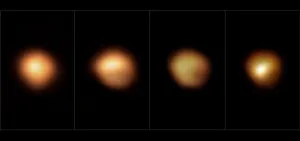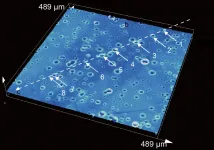Betelgeuse's dip in brightness -- a change noticeable even to the naked eye -- led Miguel Montargès and his team to point ESO's VLT (https://www.eso.org/public/teles-instr/paranal-observatory/vlt/) towards the star in late 2019. An image from December 2019, when compared to an earlier image taken in January of the same year (https://www.eso.org/public/videos/eso2003c/), showed that the stellar surface was significantly darker, especially in the southern region. But the astronomers weren't sure why.
The team continued observing the star during its Great Dimming, capturing two other never-before-seen images in January 2020 (https://www.eso.org/public/images/eso2109d/) and March 2020 (https://www.eso.org/public/images/eso2109c/). By April 2020, the star had returned to its normal brightness.
"For once, we were seeing the appearance of a star changing in real time on a scale of weeks," says Montargès, from the Observatoire de Paris, France, and KU Leuven, Belgium. The images now published (https://www.eso.org/public/videos/eso2109b/) are the only ones we have that show Betelgeuse's surface changing in brightness over time.
In their new study, published today in Nature, the team revealed that the mysterious dimming was caused by a dusty veil shading the star, which in turn was the result of a drop in temperature on Betelgeuse's stellar surface.
Betelgeuse's surface regularly changes as giant bubbles of gas move, shrink and swell within the star. The team concludes that some time before the Great Dimming, the star ejected a large gas bubble that moved away from it. When a patch of the surface cooled down shortly after, that temperature decrease was enough for the gas to condense into solid dust (https://www.eso.org/public/videos/eso2109c/).
"We have directly witnessed the formation of so-called stardust," says Montargès, whose study provides evidence that dust formation can occur very quickly and close to a star's surface. "The dust expelled from cool evolved stars, such as the ejection we've just witnessed, could go on to become the building blocks of terrestrial planets and life," adds Emily Cannon, from KU Leuven, who was also involved in the study.
Rather than just the result of a dusty outburst, there was some speculation online that Betelgeuse's drop in brightness could signal its imminent death in a spectacular supernova explosion. A supernova hasn't been observed in our galaxy since the 17th century (https://en.wikipedia.org/wiki/Kepler's_Supernova), so present-day astronomers aren't entirely sure what to expect from a star in the lead-up to such an event. However, this new research confirms that Betelgeuse's Great Dimming was not an early sign that the star was heading towards its dramatic fate.
Witnessing the dimming of such a recognisable star was exciting for professional and amateur astronomers alike, as summed up by Cannon: "Looking up at the stars at night, these tiny, twinkling dots of light seem perpetual. The dimming of Betelgeuse breaks this illusion."
The team used the Spectro-Polarimetric High-contrast Exoplanet REsearch (SPHERE - https://www.eso.org/public/teles-instr/paranal-observatory/vlt/vlt-instr/sphere/) instrument on ESO's VLT to directly image the surface of Betelgeuse, alongside data from the GRAVITY (https://www.eso.org/public/teles-instr/paranal-observatory/vlt/vlt-instr/gravity/) instrument on ESO's Very Large Telescope Interferometer (VLTI - https://www.eso.org/public/teles-instr/technology/interferometry/), to monitor the star throughout the dimming. The telescopes, located at ESO's Paranal Observatory (https://www.eso.org/public/teles-instr/paranal-observatory/) in Chile's Atacama Desert, were a "vital diagnostic tool in uncovering the cause of this dimming event," says Cannon. "We were able to observe the star not just as a point but could resolve the details of its surface and monitor it throughout the event," Montargès adds.
Montargès and Cannon are looking forward to what the future of astronomy, in particular what ESO's Extremely Large Telescope (ELT - https://elt.eso.org/), will bring to their study of Betelgeuse, a red supergiant star (https://en.wikipedia.org/wiki/Red_supergiant_star). "With the ability to reach unparalleled spatial resolutions, the ELT will enable us to directly image Betelgeuse in remarkable detail," says Cannon. "It will also significantly expand the sample of red supergiants for which we can resolve the surface through direct imaging, further helping us to unravel the mysteries behind the winds of these massive stars."
INFORMATION:
More information
This research was presented in the paper "A dusty veil shading Betelgeuse during its Great Dimming" (https://www.nature.com/articles/s41586-021-03546-8) (https://doi.org/10.1038/s41586-021-03546-8) to appear in Nature.
The team is composed of M. Montargès (LESIA, Observatoire de Paris, Université PSL, CNRS, Sorbonne Université, Université de Paris France [LESIA] and Institute of Astronomy, KU Leuven, Belgium [KU Leuven]), E. Cannon (KU Leuven), E. Lagadec (Université Côte d'Azur, Observatoire de la Côte d'Azur, CNRS, Laboratoire Lagrange, Nice, France [OCA]), A. de Koter (Anton Pannekoek Institute for Astronomy, University of Amsterdam, The Netherlands and KU Leuven), P. Kervella (LESIA), J. Sanchez-Bermudez (Max Planck Institute for Astronomy, Heidelberg, Germany [MPIA] and Instituto de Astronomía, Universidad Nacional Autónoma de México, Mexico City, Mexico), C. Paladini (European Southern Observatory, Santiago, Chile [ESO-Chile]), F. Cantalloube (MPIA), L. Decin (KU Leuven and School of Chemistry, University of Leeds, UK), P. Scicluna (ESO-Chile), K. Kravchenko (Max Planck Institute for Extraterrestrial Physics, Germany), A. K. Dupree (Center for Astrophysics | Harvard & Smithsonian, Cambridge, MA, USA), S. Ridgway (NSF's NOIRLab, Tucson, AZ, USA), M. Wittkowski (European Southern Observatory, Garching bei Munchen, Germany [ESO-Garching]), N. Anugu (Steward Observatory, University of Arizona, Tucson, AZ, USA and School of Physics and Astronomy, University of Exeter, UK [Exeter]), R. Norris (Physics Department, New Mexico Institute of Mining and Technology, Socorro, USA), G. Rau (NASA Goddard Space Flight Center, Exoplanets & Stellar Astrophysics Laboratory, Greenbelt, MD, USA [NASA Goddard] and Department of Physics, Catholic University of America, Washington, DC USA), G. Perrin (LESIA), A. Chiavassa (OCA), S. Kraus (Exeter), J. D. Monnier (Department of Astronomy, University of Michigan, Ann Arbor, MI, USA [Michigan]), F. Millour (OCA), J.-B. Le Bouquin (Univ. Grenoble Alpes, CNRS, IPAG, Grenoble, France and Michigan), X. Haubois (ESO-Chile), B. Lopez (OCA), P. Stee (OCA), and W. Danchi (NASA Goddard).
ESO is the foremost intergovernmental astronomy organisation in Europe and the world's most productive ground-based astronomical observatory by far. It has 16 Member States: Austria, Belgium, the Czech Republic, Denmark, France, Finland, Germany, Ireland, Italy, the Netherlands, Poland, Portugal, Spain, Sweden, Switzerland and the United Kingdom, along with the host state of Chile and with Australia as a Strategic Partner. ESO carries out an ambitious programme focused on the design, construction and operation of powerful ground-based observing facilities enabling astronomers to make important scientific discoveries. ESO also plays a leading role in promoting and organising cooperation in astronomical research. ESO operates three unique world-class observing sites in Chile: La Silla, Paranal and Chajnantor. At Paranal, ESO operates the Very Large Telescope and its world-leading Very Large Telescope Interferometer as well as two survey telescopes, VISTA working in the infrared and the visible-light VLT Survey Telescope. Also at Paranal ESO will host and operate the Cherenkov Telescope Array South, the world's largest and most sensitive gamma-ray observatory. ESO is also a major partner in two facilities on Chajnantor, APEX and ALMA, the largest astronomical project in existence. And on Cerro Armazones, close to Paranal, ESO is building the 39-metre Extremely Large Telescope, the ELT, which will become "the world's biggest eye on the sky".
Links
* Research paper - https://www.eso.org/public/archives/releases/sciencepapers/eso2109/eso2109a.pdf
* Behind the Paper blog post published on Nature Communities (not available during the embargo period) - https://astronomycommunity.nature.com/posts/imaging-the-great-dimming-of-betelgeuse
* Photos of the VLT and VLTI - http://www.eso.org/public/images/archive/category/paranal/
* For journalists: subscribe to receive our releases under embargo in your language] - https://www.eso.org/public/outreach/pressmedia/#epodpress_form
* For scientists: got a story? Pitch your research - http://eso.org/sci/publications/announcements/sciann17277.html
Contacts
Miguel Montargès
LESIA, Observatoire de Paris, PSL University
Paris, France
Tel: +33 (0)1 45 07 76 95
Email: miguel.montarges@observatoiredeparis.psl.eu
Emily Cannon
Institute of Astronomy, KU Leuven
Leuven, Belgium
Email: emily.cannon@kuleuven.be
Bárbara Ferreira
ESO Media Manager
Garching bei München, Germany
Tel: +49 89 3200 6670
Cell: +49 151 241 664 00
Email: press@eso.org




